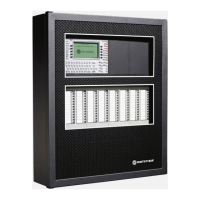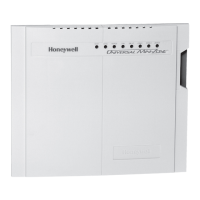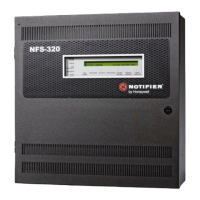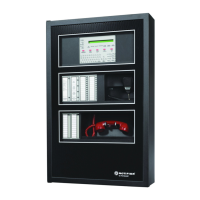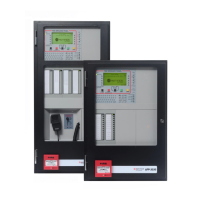Do you have a question about the Honeywell 3-144C and is the answer not in the manual?
Details the five variants of the Galaxy 3 Series control panels and their differences.
Provides a detailed diagram of the Galaxy 3 Series main PCB components.
Explains the function and connection of the RS485 Expansion Module for G3-520.
Outlines general installation and mains wiring procedures for the control panel.
Details how to connect the control panel to the Public Switched Telephone Network (PSTN).
Describes connecting extra telecom devices via a BT secondary socket.
Explains how the on-board Telecom Module monitors communication status via an LED.
Covers the requirements and installation of stand-by batteries for the Galaxy control panels.
Explains the procedure for powering up the system using the Battery Start-up jumper.
Details the PSU's function, fuses, and power monitoring characteristics.
Describes the memory chip, its backup, and procedures for warm/cold starts.
Explains the RS485 communication protocol and module monitoring.
Outlines daisy-chain wiring requirements and termination for RS485 lines.
Provides guidelines for efficient system communication and cable usage.
Details default zone functions and their programming.
Explains the structure and logic behind zone address numbering.
Describes how the RIO switch controls onboard RIO addressing.
Explains zone wiring methods (Double Balanced, End of Line) and resistance conditions.
Details wiring and operation of latching and spring-loaded keyswitches.
Explains wiring and operation of push-set terminator buttons.
Lists on-board outputs, their functions, ratings, and default states.
Illustrates typical applications for transistorised and relay outputs.
Explains the SPI header's use for copying and updating programming.
Introduces RIO modules, their expansion capabilities, and wiring.
Details how to assign unique addresses to RIO modules using the rotary switch.
Explains the wiring requirements for connecting RIO modules to the system.
Describes how to configure RIO modules and interpret LED status indicators.
Lists RIO output functions and pull-up resistors.
Explains how to configure a RIO as an Entry/Exit RIO for specific area protection.
Details zone functions and programming for Entry/Exit RIOs.
Describes the armed/disarmed operation and exit/entry time of the Entry/Exit RIO.
Explains the configuration and operation of a RIO as a Slave or Shunt RIO.
Introduces the RF RIO module for wireless zone support.
Lists the key features of the RF RIO module.
Specifies which Galaxy panels are compatible with the RF RIO.
Details the wiring requirements for connecting the RF RIO.
Lists RF RIO output functions and pull-up resistors.
Explains the tamper detection mechanism on the RF RIO.
Details how to assign addresses to the RF RIO using the rotary switch.
Explains how to program RIO addresses for the RF RIO.
Outlines how to program the RF RIO using a keypad.
Describes the configuration process and LED status for the RF RIO.
Introduces the Output Module and its expansion capabilities.
Details how to assign unique addresses to Output Modules.
Explains the wiring requirements for connecting Output Modules.
Describes the configuration process, identical to RIOs.
Details primary and secondary outputs on the Output Module.
Explains how to connect primary and secondary outputs.
Details how DIP switches determine the number of active outputs.
Explains how outputs are assigned to connectors based on address.
Describes the buzzer jumper for output signal changes.
Details the MODE, TEST, and TAMPER Bypass jumpers.
Explains connecting and configuring up to four Relay Modules.
Lists dimensions, operating temp, voltage, and current for the Output Module.
Lists dimensions, power, temp, current, and load for the Relay Module.
Introduces the Galaxy PSU variants and their integration.
Details PSU module connection and its use as a RIO alternative.
Provides step-by-step instructions for installing the PSU enclosure.
Specifies battery capacity requirements for the PSU.
Describes the PSU's automatic battery test and deep discharge protection.
Lists electrical, voltage, current, and temperature specs for the PSU.
Details EN50131 compliance for the PSU.
Details PD6662 compliance for the PSU.
Explains connecting a serial printer via the interface module.
Introduces the Telecom Module for digital communication and remote servicing.
Details connecting the Telecom Module to the Public Switched Telephone Network.
Explains how to program the Telecom Module via the control panel.
Details the RS232 module for PC and printer communication.
Describes linking the panel to a PC for remote servicing.
Explains using the RS232 module as a serial printer interface.
Introduces the ISDN Module for signalling and remote servicing over ISDN.
Explains how to program the ISDN Module via the control panel.
Introduces the Ethernet Module for LAN/WAN communication and signalling.
Describes the configuration process and LED status for the Ethernet Module.
Explains the LEDs indicating Ethernet module connection and data activity.
Describes software for remote servicing and event monitoring.
Details the Event Monitoring software for storing alarm data.
Describes Galaxy Gold software for panel communication and programming.
Details software for managing user codes and holiday changes.
Lists the features of the Galaxy Mk7 keypad and keyProx.
Details the current draw of the Mk7 Keypad and KeyProx in different modes.
Explains the wiring process for keypads and keyprox units.
Shows valid addresses for keypads and keyprox on different Galaxy panels.
Provides a step-by-step guide for installing keypads and keyprox units.
Describes the volume control switch for buzzer functions on the keypad.
Outlines the procedure for adding new keypads/keyprox to the system.
Details the procedure for removing keypads/keyprox from the system.
Explains the keypad's self-diagnostic test feature.
Details the operation of number keys, view keys, and enter key.
Explains the use of number keys for PIN entry and option selection.
Describes the function of the A and B keys for system setting.
Explains the function of the 'ent' key for menu access and confirmation.
Details the function of the 'esc' key for cancelling or returning.
Explains the use of the '#' key for programming features and activating duress.
Details the use of the '*' key for correcting PINs and displaying group status.
Specific notes on group display for the Galaxy 3-520.
Explains the meaning of the green power LED status indicators.
Describes the 2x16 character backlit display for programming and status.
Introduces the KeyProx with integrated card reader.
Describes the KeyProx as a keypad with a built-in proximity reader.
Explains address sharing between KeyProx keypad and reader.
States KeyProx operation is identical to Mk7 keypad.
Mentions KeyProx reading ASK type cards and self-learn feature.
Introduces the MAX3 as a proximity reader for access control and alarm setting.
Describes the MAX3 configuration for independent door control or alarm set/unset.
Describes the MAX3 configuration for integrated operation with the Galaxy panel.
Details the contents of the MAX3 pack and mounting.
Lists the components included in the MAX3 pack.
Provides instructions for mounting the MAX3 unit.
Illustrates wiring configurations for MAX3 in online and standalone modes.
Guides on configuring MAX3 readers into the Galaxy system from engineer mode.
Details the steps to configure the MAX3 reader as an on-line module.
Details the steps to configure the MAX3 reader as a stand-alone module.
Explains how to remove MAX3 readers from the system in both modes.
Describes how to gain access using MAX3 reader with user cards.
Step-by-step guide for gaining access with a MAX3 reader.
Explains nightlock access for stand-alone MAX3 readers.
Describes assigning functions to MAX3 cards.
Explains how card-held functions initiate setting procedures for groups.
Details the event log for recording MAX3 activations.
Explains how to print MAX3 events to an on-line printer.
Describes downloading the MAX3 log to Galaxy Gold.
Explains the functionality of Dual Access cards with MAX3.
Describes the Dual Focus function for card-held operations.
Explains the Timed Anti-Passback feature and forgiveness functions.
Lists contents of the MAX box and installation sequence.
Details MAX wiring for door strike, horn, egress, and contact.
Provides instructions for surface and flush mounting the MAX reader.
Guides on configuring MAX readers into the Galaxy system.
Details steps for configuring MAX reader as stand-alone.
Details steps for configuring MAX reader as on-line.
Explains how to remove MAX readers from the system.
Restricts function operation to groups common to card and MAX.
Details removing MAX readers in Stand Alone and On-Line modes.
Refers to system operation for programming parameters.
Describes gaining access using MAX3 reader with user cards.
Step-by-step guide for gaining access with a MAX3 reader.
Explains nightlock access for stand-alone MAX3 readers.
Describes assigning functions to MAX3 cards.
Explains how card-held functions initiate setting procedures for groups.
Details the event log for recording MAX activations.
Explains how to print MAX events to an on-line printer.
Details the Smart PSU's integration and connection to Galaxy panels.
Explains the grounding procedure for the Smart PSU.
Lists default functions and resistors for Smart PSU outputs.
Compares features and capabilities of Galaxy 3-48, 3-144, and 3-520 panels.
Lists standards and approvals the Galaxy 3 Series complies with.
Details EN50131 compliance grades and classes for the product.
Details PD6662 compliance for the product.
States PSTN approval and network compatibility.
Provides mechanical and electrical specifications for the Galaxy panels.
Lists weight and order codes for various system modules.
Lists weight and order codes for printed circuit boards.
Shows quiescent current consumption for various devices.
An alphabetical index of product names, part numbers, and comments.
Details the five variants of the Galaxy 3 Series control panels and their differences.
Provides a detailed diagram of the Galaxy 3 Series main PCB components.
Explains the function and connection of the RS485 Expansion Module for G3-520.
Outlines general installation and mains wiring procedures for the control panel.
Details how to connect the control panel to the Public Switched Telephone Network (PSTN).
Describes connecting extra telecom devices via a BT secondary socket.
Explains how the on-board Telecom Module monitors communication status via an LED.
Covers the requirements and installation of stand-by batteries for the Galaxy control panels.
Explains the procedure for powering up the system using the Battery Start-up jumper.
Details the PSU's function, fuses, and power monitoring characteristics.
Describes the memory chip, its backup, and procedures for warm/cold starts.
Explains the RS485 communication protocol and module monitoring.
Outlines daisy-chain wiring requirements and termination for RS485 lines.
Provides guidelines for efficient system communication and cable usage.
Details default zone functions and their programming.
Explains the structure and logic behind zone address numbering.
Describes how the RIO switch controls onboard RIO addressing.
Explains zone wiring methods (Double Balanced, End of Line) and resistance conditions.
Details wiring and operation of latching and spring-loaded keyswitches.
Explains wiring and operation of push-set terminator buttons.
Lists on-board outputs, their functions, ratings, and default states.
Illustrates typical applications for transistorised and relay outputs.
Explains the SPI header's use for copying and updating programming.
Introduces RIO modules, their expansion capabilities, and wiring.
Details how to assign unique addresses to RIO modules using the rotary switch.
Explains the wiring requirements for connecting RIO modules to the system.
Describes how to configure RIO modules and interpret LED status indicators.
Lists RIO output functions and pull-up resistors.
Explains how to configure a RIO as an Entry/Exit RIO for specific area protection.
Details zone functions and programming for Entry/Exit RIOs.
Describes the armed/disarmed operation and exit/entry time of the Entry/Exit RIO.
Explains the configuration and operation of a RIO as a Slave or Shunt RIO.
Introduces the RF RIO module for wireless zone support.
Lists the key features of the RF RIO module.
Specifies which Galaxy panels are compatible with the RF RIO.
Details the wiring requirements for connecting the RF RIO.
Lists RF RIO output functions and pull-up resistors.
Explains the tamper detection mechanism on the RF RIO.
Details how to assign addresses to the RF RIO using the rotary switch.
Explains how to program RIO addresses for the RF RIO.
Outlines how to program the RF RIO using a keypad.
Describes the configuration process and LED status for the RF RIO.
Introduces the Output Module and its expansion capabilities.
Details how to assign unique addresses to Output Modules.
Explains the wiring requirements for connecting Output Modules.
Describes the configuration process, identical to RIOs.
Details primary and secondary outputs on the Output Module.
Explains how to connect primary and secondary outputs.
Details how DIP switches determine the number of active outputs.
Explains how outputs are assigned to connectors based on address.
Describes the buzzer jumper for output signal changes.
Details the MODE, TEST, and TAMPER Bypass jumpers.
Explains connecting and configuring up to four Relay Modules.
Lists dimensions, operating temp, voltage, and current for the Output Module.
Lists dimensions, power, temp, current, and load for the Relay Module.
Introduces the Galaxy PSU variants and their integration.
Details PSU module connection and its use as a RIO alternative.
Provides step-by-step instructions for installing the PSU enclosure.
Specifies battery capacity requirements for the PSU.
Describes the PSU's automatic battery test and deep discharge protection.
Lists electrical, voltage, current, and temperature specs for the PSU.
Details EN50131 compliance for the PSU.
Details PD6662 compliance for the PSU.
Explains connecting a serial printer via the interface module.
Introduces the Telecom Module for digital communication and remote servicing.
Details connecting the Telecom Module to the Public Switched Telephone Network.
Explains how to program the Telecom Module via the control panel.
Details the RS232 module for PC and printer communication.
Describes linking the panel to a PC for remote servicing.
Explains using the RS232 module as a serial printer interface.
Introduces the ISDN Module for signalling and remote servicing over ISDN.
Explains how to program the ISDN Module via the control panel.
Introduces the Ethernet Module for LAN/WAN communication and signalling.
Describes the configuration process and LED status for the Ethernet Module.
Explains the LEDs indicating Ethernet module connection and data activity.
Describes software for remote servicing and event monitoring.
Details the Event Monitoring software for storing alarm data.
Describes Galaxy Gold software for panel communication and programming.
Details software for managing user codes and holiday changes.
Lists the features of the Galaxy Mk7 keypad and keyProx.
Details the current draw of the Mk7 Keypad and KeyProx in different modes.
Explains the wiring process for keypads and keyprox units.
Shows valid addresses for keypads and keyprox on different Galaxy panels.
Provides a step-by-step guide for installing keypads and keyprox units.
Describes the volume control switch for buzzer functions on the keypad.
Outlines the procedure for adding new keypads/keyprox to the system.
Details the procedure for removing keypads/keyprox from the system.
Explains the keypad's self-diagnostic test feature.
Details the operation of number keys, view keys, and enter key.
Explains the use of number keys for PIN entry and option selection.
Describes the function of the A and B keys for system setting.
Explains the function of the 'ent' key for menu access and confirmation.
Details the function of the 'esc' key for cancelling or returning.
Explains the use of the '#' key for programming features and activating duress.
Details the use of the '*' key for correcting PINs and displaying group status.
Specific notes on group display for the Galaxy 3-520.
Explains the meaning of the green power LED status indicators.
Describes the 2x16 character backlit display for programming and status.
Introduces the KeyProx with integrated card reader.
Describes the KeyProx as a keypad with a built-in proximity reader.
Explains address sharing between KeyProx keypad and reader.
States KeyProx operation is identical to Mk7 keypad.
Mentions KeyProx reading ASK type cards and self-learn feature.
Introduces the MAX3 as a proximity reader for access control and alarm setting.
Describes the MAX3 configuration for independent door control or alarm set/unset.
Describes the MAX3 configuration for integrated operation with the Galaxy panel.
Details the contents of the MAX3 pack and mounting.
Lists the components included in the MAX3 pack.
Provides instructions for mounting the MAX3 unit.
Illustrates wiring configurations for MAX3 in online and standalone modes.
Guides on configuring MAX3 readers into the Galaxy system from engineer mode.
Details the steps to configure the MAX3 reader as an on-line module.
Details the steps to configure the MAX3 reader as a stand-alone module.
Explains how to remove MAX3 readers from the system in both modes.
Describes how to gain access using MAX3 reader with user cards.
Step-by-step guide for gaining access with a MAX3 reader.
Explains nightlock access for stand-alone MAX3 readers.
Describes assigning functions to MAX3 cards.
Explains how card-held functions initiate setting procedures for groups.
Details the event log for recording MAX3 activations.
Explains how to print MAX3 events to an on-line printer.
Describes downloading the MAX3 log to Galaxy Gold.
Explains the functionality of Dual Access cards with MAX3.
Describes the Dual Focus function for card-held operations.
Explains the Timed Anti-Passback feature and forgiveness functions.
Lists contents of the MAX box and installation sequence.
Details MAX wiring for door strike, horn, egress, and contact.
Provides instructions for surface and flush mounting the MAX reader.
Guides on configuring MAX readers into the Galaxy system.
Details steps for configuring MAX reader as stand-alone.
Details steps for configuring MAX reader as on-line.
Explains how to remove MAX readers from the system.
Restricts function operation to groups common to card and MAX.
Details removing MAX readers in Stand Alone and On-Line modes.
Refers to system operation for programming parameters.
Describes gaining access using MAX3 reader with user cards.
Step-by-step guide for gaining access with a MAX3 reader.
Explains nightlock access for stand-alone MAX3 readers.
Describes assigning functions to MAX3 cards.
Explains how card-held functions initiate setting procedures for groups.
Details the event log for recording MAX activations.
Explains how to print MAX events to an on-line printer.
Details the Smart PSU's integration and connection to Galaxy panels.
Explains the grounding procedure for the Smart PSU.
Lists default functions and resistors for Smart PSU outputs.
Compares features and capabilities of Galaxy 3-48, 3-144, and 3-520 panels.
Lists standards and approvals the Galaxy 3 Series complies with.
Details EN50131 compliance grades and classes for the product.
Details PD6662 compliance for the product.
States PSTN approval and network compatibility.
Provides mechanical and electrical specifications for the Galaxy panels.
Lists weight and order codes for various system modules.
Lists weight and order codes for printed circuit boards.
Shows quiescent current consumption for various devices.
An alphabetical index of product names, part numbers, and comments.
| Brand | Honeywell |
|---|---|
| Model | 3-144C |
| Category | Control Panel |
| Language | English |






